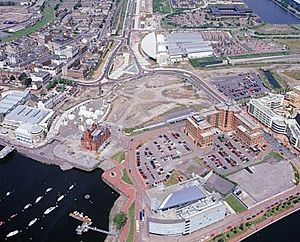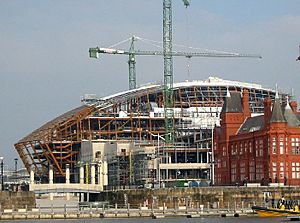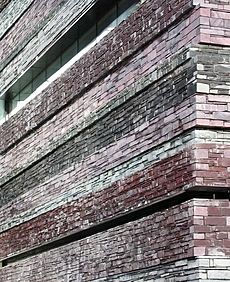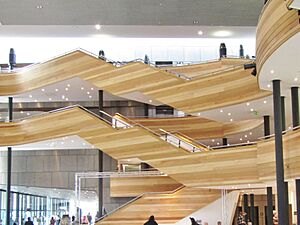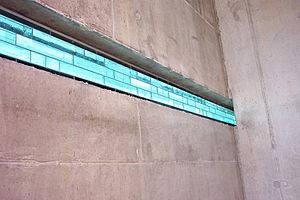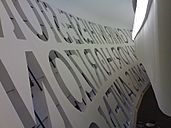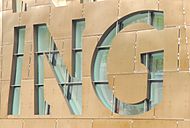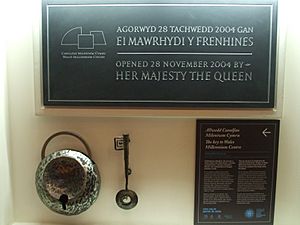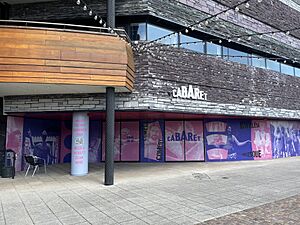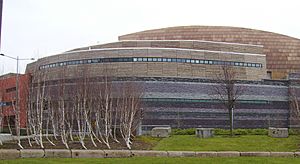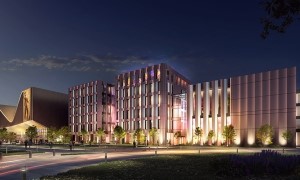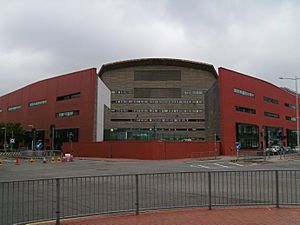Wales Millennium Centre facts for kids
|
The Armadillo
|
|

Logo used since 2019
|
|
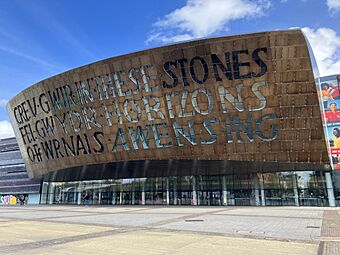
Main entrance to the Wales Millennium Centre on Roald Dahl Plass
|
|
| Location | Bute Place, Cardiff Bay, Cardiff, Wales |
|---|---|
| Coordinates | 51°27′54.14″N 3°9′48.72″W / 51.4650389°N 3.1635333°W |
| Owner | Phase 1: Wales Millennium Centre Phase 2: Lime Property Fund (Aviva Investors) |
| Operator | Phase 1: Wales Millennium Centre Phase 2: BBC |
| Type | Company limited by guarantee |
| Capacity | Donald Gordon Theatre: 1,897 BBC Hoddinott Hall: 350 Weston Studio Theatre: 250 Cabaret: 140 Grace Williams Studio: 60 |
| Construction | |
| Broke ground | February 2002 |
| Opened | Phase 1: 26–28 November 2004 Phase 2: 31 January 2009 |
| Renovated | 2022/3 (Phase 1 Refurbishment) |
| Construction cost | Phase 1: £106.2 million Phase 2: £18 million Phase 1 Refurbishment: £4 million |
| Architect | Phase 1: Jonathan Adams (Percy Thomas Partnership) Phase 2: Tim Green and Keith Vince (Capita Percy Thomas) Phase 1 Refurbishment: Richard H Powell (interior designers) |
| Structural engineer | Arup Group |
| Main contractors | Sir Robert McAlpine |
| Tenants | |
|
|
|
Building details
|
|
| Technical details | |
| Material | 4,500 tonnes of structural steel 2,000 tonnes of recycled Welsh slate (cladding) |
| Floor count | 6 |
| Floor area | 37,000 m2 (400,000 sq ft) |
| Lifts/elevators | 2 |
The Wales Millennium Centre (also known as Canolfan Mileniwm Cymru in Welsh) is a huge building in Cardiff Bay, Wales. It's a national arts centre, which means it's a special place for all kinds of performances and creative activities. The whole area it covers is about 7.5 acres, which is like having five football fields!
The first part of the building opened in November 2004, and the second part opened in January 2009 with a special concert. The Centre is Cardiff's main place for big shows like opera, ballet, contemporary dance, and musicals.
It has a large theatre and a smaller hall, plus a shop, bars, and a café. It's home to the BBC National Orchestra and Chorus of Wales, and seven other arts groups. In 2012, the Centre started creating its own shows, which have been performed in London, Edinburgh, and Australia.
The main theatre, called the Donald Gordon Theatre, has 1,896 seats. It has one of the largest stages in Europe. The BBC Hoddinott Hall seats 350 people, and the Weston Studio Theatre seats 250.
Contents
- How the Centre Began
- Phase 1: Donald Gordon Theatre and Weston Studio
- Phase 2: BBC Hoddinott Hall and Grace Williams Studio
- Phase 3: A New Digital Arts Theatre
- Groups Based at the Centre
- Funding and Rebranding
- See also
How the Centre Began
The First Idea: Cardiff Bay Opera House
Before the Wales Millennium Centre, there was a plan to build an opera house in Cardiff Bay. This project was meant to be a permanent home for the Welsh National Opera.
A worldwide competition was held to design the building, and 268 architects entered. Zaha Hadid, an architect from Iraq, won with her very modern design. Her design was so unique that she was asked to submit it again, and she won a second time!
However, in 1995, the Millennium Commission, which gave out money from the UK National Lottery, decided not to fund the opera house. Some people thought this was because the government wanted to fund projects that seemed more popular, like the Millennium Stadium.
The Birth of Wales Millennium Centre
After the opera house plan was turned down, a new idea came about. This new project would include more than just opera and would better represent Welsh culture. The name change to Wales Millennium Centre showed this new goal.
Even with the new plan, getting money was still hard. It took years to get funding from the Welsh Assembly and the Millennium Commission. The Cardiff Council had to buy the land because the previous owner threatened to build a shopping centre there due to the delays.
Big donations from a South African businessman named Donald Gordon and a loan from HSBC bank helped a lot. Donald Gordon's £20 million donation was split between the Royal Opera House and the Wales Millennium Centre. This was one of the biggest private donations ever made to the arts in the UK.
Phase 1: Donald Gordon Theatre and Weston Studio
Besides the two main theatres, the Donald Gordon Theatre and the Weston Studio, the first part of the Wales Millennium Centre has many other rooms. Urdd Gobaith Cymru, a Welsh youth organisation, has a hostel called the Urdd City Sleepover. It has rooms for 153 people to stay overnight.
The building also has rehearsal rooms, special facilities for the Welsh National Opera, and dance studios. The Blue Room is a performance and teaching space for the National Dance Company Wales.
There are three bars: the Awen Bar, the Horizons Bar, and the Stones Bar. The Ffwrnais café-bar and the One wine bar are in the main lobby. Sometimes, free shows happen in the lobby on the Glanfa stage.
Design and Building
The Wales Millennium Centre was designed by Jonathan Adams from Percy Thomas Architects. His first ideas for the building were drawn in 1998. By 1999, the design started to look like the building we see today.
Building work began on February 25, 2002. Many different companies helped build it. The architect wanted the building to look and feel "Welsh" and be easy to recognise. The design uses materials important to Welsh history: slate, metal, wood, and glass. Many of these materials came from Wales, including 1,350 tonnes of Welsh slate.
Slate: A Story in Stone
The outside of the building is covered in colourful slate from Welsh quarries. Thin windows are placed between the layers of slate. This makes the building look like rock layers in sea cliffs. The purple slate came from Penrhyn Quarry, blue from Cwt y Bugail, green from Nantlle Valley, grey from Llechwedd, and black from Corris Quarry.
Jonathan Adams, the architect, said he was inspired by the cliffs at Ogmore and Southerndown. He wanted the building to look like those cliffs, strong enough to last for hundreds of years. He used waste slate from North Wales quarries, which was perfect for the walls.
Metal: Strong and Shiny
The Centre's most striking part is the bronze-coloured dome over the Donald Gordon Theatre. It's covered in stainless steel. The bronze colour isn't paint; it's created by a special chemical process that makes the metal look iridescent. This design helps it stand up to the weather by Cardiff Bay and look better as it gets older.
Jonathan Adams chose not to use copper or aluminium because they would change colour over time. He wanted the steel to have a rough, industrial look, like old factories in South Wales.
Wood: From Forest to Foyer
Inside and outside the building, including the main theatre and balconies, you'll see many bands of hardwood. These woods, like Oak, ash, beech, and sycamore, come from sustainable forests in mid-Wales.
The design of the main hall is meant to look like the edge of a forest. This is because the edge of a forest is often seen as a magical place, much like the front of a theatre stage. The curving shapes and columns make it feel like you're among trees.
Glass: Light and Layers
Glass is used within the layers of slate on the outside. These glass pieces are 15 cm thick and were cut by students at Swansea Institute of Higher Education. The architect wanted to use glass in a unique way, stacking and fusing sheets together to make solid blocks.
Calligraphy: Words on the Wall
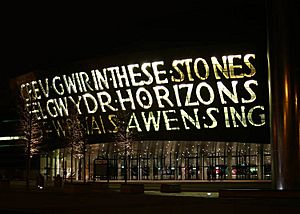
On the front of the dome, above the main entrance, are two lines of writing by Welsh poet Gwyneth Lewis. They are in both Welsh and English. These letters are actually windows in the upstairs bar areas and light up at night.
The idea for these words came from ancient Roman buildings. The architect, Jonathan Adams, felt it was important to show Wales's two languages. He said, "Words in songs, stories and poems have helped to make Wales the proud country that it is."
Gwyneth Lewis explained that she wanted the words to match the building's design. The copper dome reminded her of old Welsh furnaces and a magical cauldron from Welsh stories. The words "Awen" (Welsh for inspiration) and "In These Stones Horizons Sing" were chosen. The English words are not just a translation; they have their own meaning, talking about how the sea connects Wales to the world.
The phrase In These Stones Horizons Sing also became the title of an orchestral piece. It was composed by Karl Jenkins for the Centre's opening.
Opening Weekend Celebration
The Centre officially opened from November 26 to 28, 2004. Famous Welsh singer Bryn Terfel organised the celebration.
Day 1: November 26, 2004
The day began with speeches. Lord Rowe-Beddoe, the Centre's chairman, started the event. Then, Rhodri Morgan, the First Minister, said the Centre was for everyone in Wales.
A young mother from Barry, Janet Thickpenny, officially opened the building. She was chosen because her 40th birthday was on the opening day. A special key was passed along a human chain to Janet. This was followed by music from the National Youth Brass Band of Wales.
The evening show, Cymru for the World, celebrated five great Welsh artists: Gwyneth Jones, Shirley Bassey, Siân Phillips, Alun Hoddinott, and Richard Burton. Many famous people gave tributes. The concert featured singers and dancers telling the story of the building's construction. The Welsh National Opera also performed.
Day 2: November 27, 2004
On the second day, the Centre opened its doors to the public. Many people came to explore the building. The day ended with a fireworks display in Roald Dahl Plass.
Day 3: November 28, 2004
The final day of the opening weekend saw Queen Elizabeth II, Prince Philip, and the Prince of Wales visit. They met the First Minister and Lord Rowe-Beddoe and unveiled a plaque. Richard Burton's granddaughter presented a key to the Queen. Many artists performed, including Charlotte Church and Only Men Aloud!. The Kirov Ballet and Cirque Éloize also entertained the audience. Bryn Terfel closed the celebrations.
2022/23 Updates: Cabaret and Bocs
In 2022 and 2023, the Centre had some updates. An "immersive theatre" space called Bocs (Welsh for 'box') opened in August 2022. It shows 360° films and uses extended reality technology.
In September 2022, a £4 million update was announced. This included a new area for cabaret shows, a redesigned lobby, and a new ticket office. A 12-metre-long bar and a members' lounge were also added. The new 140-seat cabaret venue, simply called Cabaret, opened in February 2023. It hosts drag, comedy, and other performances.
Awards for Phase 1
- 2005 Gold Medal for Architecture
- 2005 RIBA Wales award
- 2005 MIPIM Awards (Hotels & Tourism resorts)
- Sustainability and Environmental Impact award from the British Institute of Facilities Management
- 2005 Interior of the Year award from FX
Phase 2: BBC Hoddinott Hall and Grace Williams Studio
The second part of the Wales Millennium Centre is home to the BBC National Orchestra of Wales (BBC NOW) and the BBC National Chorus of Wales. BBC NOW moved here because their old studio was too small.
Phase 2 opened on January 22, 2009, with a concert by BBC NOW. It includes the 350-seat BBC Hoddinott Hall, named after the Welsh composer Alun Hoddinott. There's also the Grace Williams Studio, named after another Welsh composer, Grace Williams. This studio is used for education and community work. Phase 2 also has practice rooms, a music library, and offices.
Design and Building of Phase 2
The original plans for the Centre included a concert hall, but it wasn't built in Phase 1. Space was left for it to be added later. Building on Phase 2 began in April 2007.
Phase 2 was designed to match the curved slate front of the main Centre. The upper part is made of timber. Tim Green, one of the designers, said the inside of Phase 2 was inspired by traditional Welsh chapels.
The building work finished in September 2008. Then, BBC Wales started setting up the inside of the Hoddinott Hall. The Grace Williams Studio, with 60 seats, is used for workshops and rehearsals.
Opening Festival
To celebrate the opening of BBC Hoddinott Hall, a special concert took place on January 22, 2009. This was part of an opening festival that lasted until February 1, 2009. The concert featured the BBC National Orchestra of Wales. The Prince of Wales officially opened BBC Hoddinott Hall on January 31, 2009.
Awards for Phase 2
- Engineering Excellence Award from the Association for Consultancy and Engineering.
- 2009 Special Award: Best Use of Panel Products from the Wood Awards
Phase 3: A New Digital Arts Theatre
The third part of the Wales Millennium Centre's development is a planned new theatre. It will have 550 seats and be a separate building across from the main Centre. This new theatre will focus on "immersive" arts, using technology to create exciting experiences.
It will be located next to a proposed new 15,000-seat indoor arena for Cardiff. The new theatre will also be part of the Cardiff Council's new modern headquarters.
Groups Based at the Centre
The Wales Millennium Centre is home to eight different arts organisations:
- Literature Wales – This group promotes Welsh literature and supports writers.
- National Dance Company Wales – A leading dance company.
- Hijinx Theatre – One of Europe’s top theatre companies that includes people with disabilities.
- Two Rhythms – This group provides special therapies using touch and movement for people with profound disabilities and autism.
- Tŷ Cerdd – A music centre for both amateur and professional musicians.
- Urdd Gobaith Cymru – Wales's largest youth organisation.
- Welsh National Opera – An opera company that tours internationally.
- BBC National Orchestra of Wales – The only professional national symphony orchestra for Wales.
Funding and Rebranding
The first part of the project cost £106.2 million. The National Lottery Millennium Fund gave £31.7 million, and the National Assembly for Wales gave £37 million. The Arts Council of Wales donated £10.4 million.
Donald Gordon, a private investor, gave £20 million, shared between the Royal Opera House and the Wales Millennium Centre. The Centre also got a £13.5 million loan from HSBC. Other money came from a sponsorship deal with the Principality Building Society. The Weston Studio is named after the Garfield Weston Foundation, which also provided support. Many other companies and public groups help fund the Centre.
In November 2006, the Wales Millennium Centre announced it would update its brand. A local Cardiff company, Sweet, won the project. They created a new logo and redesigned marketing materials like brochures.
See also
 In Spanish: Centro del Milenio de Gales para niños
In Spanish: Centro del Milenio de Gales para niños


